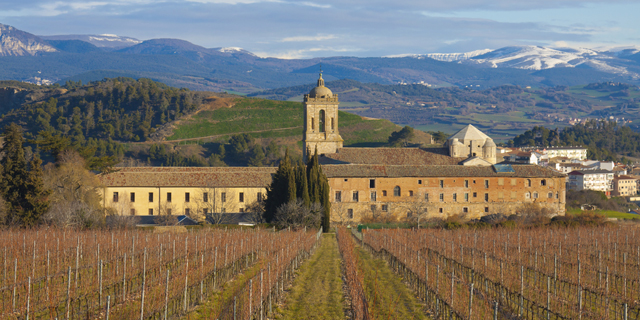It is said that the remains of St. James, the Patron Saint of Spain, are buried within the Cathedral of Santiago de Compostela. Since medieval times, pilgrims have traversed El Camino de Santiago (The Way of Saint James), seeking spiritual enlightenment on the long path to Santiago de Compostela in Galicia. Although there are many different starting points, at least four in France alone, most routes converge near the city of Pamplona, in the province of Navarra. While most peregrinos have retired to an albergo by nightfall, those who are still walking after sunset will note that the route follows the Via Lactea (Milky Way).
The Feast of Saint James is celebrated throughout all of Spain on July 25th, and El Camino de Santiago was one of three major pilgrimage routes from the 9th to the 16th centuries, when travelers would return home with a scallop shell as proof that they had completed the long trek. The scallop remains an enduring symbol of the camino: It is worn by walkers and cyclists to identify themselves as pilgrims and is used on signposts to point the way west through the wine regions of Navarra, Rioja, Ribera del Duero, and Rias Baixas.
The route itself was recognized as a Unesco World Heritage Site in the 1980’s, and there are many sites others along the way, including the Cathedral of Burgos, the Monasteries of Yuso and Suso in Rioja, and the old town of Santiago de Compostela. Emilio Estevez’ 2010 film The Way brought renewed international attention to the pilgrimage route. His time in northern Spain also inspired Estevez to plant grapes on his California lawn and start a small winery, Casa Dumetz, which he runs with his fiancée Sonja Magdevski.
Each region the route passes through has its own food and wine traditions, so journeyers are certain to be well fed and to enjoy delicious wines during the five weeks it takes to walk the whole route or the two weeks on bicycle.
Here, TLKs top spots to stop, relax, and drink wine, on the journey…
[pagebreak]Navarra: In the northeast corner of Spain, Navarra is known for its abundance of vegetables, especially white asparagus, piquillo peppers, and artichokes, and for Roncal and Idiziabal cheeses. Navarra’s wines are mainly red and rosé. Garnacha (also known as Grenache) is the grape used to make deeply colored, fruit forward rosé wines, and reds are mainly Tempranillo or Cabernet Sauvignon. There is a small amount of Chardonnay grown here as well. Look for Julian Chivite’s refreshing Gran Feudo Rosé and Vega Sindoa’s Tempranillo and Grenache.
Rioja: Rioja is a red wine paradise, featuring wines made from Tempranillo with the addition of Garnacha, Graciano, and Mazuelo (known in France as Carignan). Locals love to eat cochonillo, or suckling pig, although large steaks known as chuleton de buey and seafood from the nearby Cantabrian Sea are found on menus as well. White wines, made mainly from Viura, are aged in wood to go well with pork and cooked seafood dishes. Reds range from young and fresh through richer barrel-aged Crianzas and Reservas. Some of our favorites are Marques de Riscal, Muga, Faustino, and Palacios Remondo.
Ribera del Duero: Ribera del Duero’s delicious red wines, made mostly from Tempranillo with a little added Cabernet Sauvignon or Albillo, retain their freshness due to the region’s high elevation and cool nights. Perfect with the local specialty, grilled young lamb, the Ribera reds also go great with just about anything cooked on the grill. Lightly oaked versions, labeled Roble or Joven (as opposed to the longer-aged Crianza and Reserva wines), are delicious with seafood dishes that have a little added spice from chorizo or paprika. Although only red wines are produced here, many wineries also produce refreshing Verdejo in the nearby Rueda region. Look for bottles from Protos, Emilio Moro, Pesquera, and Arzuaga.
Rias Baixas: The main grape grown here is Albariño, used to make fresh, crisp wines that are perfect with the area’s multitude of fresh shellfish and seafood. Most are completely aged in steel, although some see a little bit of oak for a touch of spice and a richer mouthfeel. Whether you are enjoying oysters on the half shell, steamed mussels, or scallops, Albariño from Rias Baixas, in Galicia, is the perfect accompaniment. (Scallops are officially known as vieiras in Spain, although when served in the shell they are also called peregrinos.) Among our favored Albariños are Serra da Estrela, Terras Gauda, Martin Codax, and Santiago Ruiz.


![Making Mealtime Matter with La Familia: Easy Sofrito [Video]](https://thelatinkitchen.com/wp-content/uploads/2015/10/sofrito-shutterstock__0-500x383.jpg)
![Easy Latin Smoothies: Goji Berry Smoothie [Video]](https://thelatinkitchen.com/wp-content/uploads/2015/12/goji_berry-shutterstock_-500x383.jpg)
















![Fun and Fast Recipes: Fiesta Cabbage Salad [Video]](https://thelatinkitchen.com/wp-content/uploads/2015/11/fiesta_cabbage_slaw-shutterstock_-500x383.jpg)









